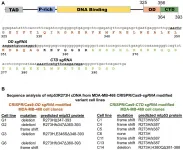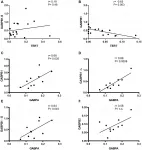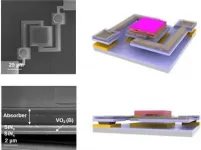(Press-News.org) DALLAS, July 26, 2021 -- Genomic studies have produced advances in how to calculate and reduce heart-disease risk, however, the benefits don't necessarily apply to people from historically marginalized racial and ethnic groups and Indigenous populations. Efforts must be made to eliminate barriers to increase their participation in genomic research, according to a new scientific statement from the American Heart Association, published today in the Association's journal Circulation: Genomic and Precision Medicine.
"Profound breakthroughs in genetic and genomic science are rapidly improving our ability to prevent, detect and treat cardiovascular disease," said Gia Mudd-Martin, Ph.D., M.P.H., R.N., FAHA, associate professor of nursing at the University of Kentucky in Lexington and chair of the writing group for the scientific statement. "Conducting research in collaboration with diverse and underrepresented populations is critical to assuring equitable health benefits."
Genetic research focuses on the scientific study of individual genes and their effects on health and disease, resulting in the identification of important single-gene disorders such as hypertrophic cardiomyopathy. Genomic research, in contrast, is the study of all genes a person has (the genome) as well as how those genes interact with each other and with lifestyle behaviors (such as diet) or factors in the environment (such as air pollution). Genome-wide association studies use the genomes of multiple people to detect patterns of genomic variation associated with health or disease, such as the risk for certain heart diseases.
According to the statement, about 80% of participants in genome-wide association studies are of European ancestry, yet this group represents only 16% of the global population.
"This limits the ability to identify genomic markers for disease risk. For example, genomic scores to determine risk for certain heart diseases are less accurate when used with ethnically and racially diverse populations or Indigenous peoples than when used with persons of European ancestry," said Mudd-Martin.
The statement highlights a need to create new, high-quality, human reference genomes representing more diverse groups of people. This means more people from diverse ethnicities and ancestry are needed to participate in medical research. "However," said Mudd-Martin, "a key barrier to participation is a deep and understandable mistrust of scientific research caused by numerous historical transgressions against marginalized racial and ethnic groups and Indigenous populations."
The most well-known cases of these are the Tuskegee Study of Untreated Syphilis in Black men, during which Black men were recruited to participate in the study with the promise of free health care yet they received placebos rather than care for syphilis; and the unapproved use of tissue from Henrietta Lacks. Lacks was a Black woman who was being treated for cervical cancer and died in 1951. Without her permission, her tissue samples were used to establish the HeLa cell line, which has been a critical source of human cells for cancer, immunology, infectious disease, genomic and cardiovascular research; the HeLa cell line is still used widely in scientific research today.
"Unfortunately, comparable atrocities similar to what happened in the Tuskegee Study of Untreated Syphilis in Black men have occurred in other marginalized racial and ethnic groups," said Mudd-Martin, "including some that are not publicly acknowledged or disclosed."
The statement offers several considerations for researchers to rebuild trust and include more diverse participants in genetic and genomic studies, including:
Creating plans to reduce inequities that emphasize the principles of respect, honesty, justice and fairness; the assurance of mutual benefit and care for the individual and community - all elements of ethical human subject treatment guidance for research worldwide;
Recognizing that race and ethnicity are social and political constructs that may or may not correlate with geographic ancestry or human genome variation in populations;
Realizing that self-identified race and ethnicity, while useful in some contexts for understanding social determinants of health, cannot be used to predict genetic factors that influence an individual's health status;
Collaborating with community stakeholders can help researchers take cultural values and interests into account in research design, ensure informed consent of participants and create a transparent system for data analysis and disseminating study findings; and
Ethically using genomic data from Indigenous communities by enhancing the accountability of researchers and ensuring that benefits are equitably shared.
"Engaging with communities, building trust and approaching research as a collaboration between researchers and community stakeholders are critical to support genetic and genomic research with marginalized racial and ethnic groups and Indigenous peoples. Each community is distinct, so plans to gather, use and share data will be distinct and must be developed in collaboration with each community," Mudd-Martin said.
INFORMATION:
This scientific statement was prepared by the volunteer writing group on behalf of the American Heart Association's Council on Genomic and Precision Medicine and the Council on Cardiovascular and Stroke Nursing.
Co-authors are Vicky A. Cameron, Ph.D., FAHA, vice chair; Allison L. Cirino, M.S., C.G.C., FAHA; Veronica Barcelona, Ph.D., M.S.N., M.P.H., R.N., P.H.N.A.-B.C.; Keolu Fox, Ph.D.; Maui Hudson, M.H.Sc.; Yan V. Sun, Ph.D., FAHA; Jacquelyn Y. Taylor, Ph.D., P.N.P.-B.C., R.N., FAHA. Author disclosures are in the manuscript.
Additional Resources:
Available multimedia is on right column of release link - https://newsroom.heart.org/news/new-statement-provides-path-to-include-ethnicity-ancestry-race-in-genomic-research?preview=d07d2f6362d26709e35d00a54b21d0fa
The Association receives funding primarily from individuals. Foundations and corporations (including pharmaceutical, device manufacturers and other companies) also make donations and fund specific Association programs and events. The Association has strict policies to prevent these relationships from influencing the science content. Revenues from pharmaceutical and biotech companies, device manufacturers and health insurance providers and the Association's overall financial information are available here.
About the American Heart Association
The American Heart Association is a relentless force for a world of longer, healthier lives. We are dedicated to ensuring equitable health in all communities. Through collaboration with numerous organizations, and powered by millions of volunteers, we fund innovative research, advocate for the public's health and share lifesaving resources. The Dallas-based organization has been a leading source of health information for nearly a century. Connect with us on heart.org, Facebook, Twitter or by calling 1-800-AHA-USA1.
NEW YORK, NY (July 26, 2021)--Two types of drugs that are recommended as a first treatment for patients with high blood pressure were found equally effective in improving cardiovascular outcomes, but the more popular type causes slightly more side effects, finds a multinational observational study led by researchers at Columbia University Vagelos College of Physicians and Surgeons.
The study, which analyzed claims and electronic health data from millions of patients worldwide, is the largest to compare the safety and efficacy of angiotensin-converting ...
Citrus fruits from the mandarin family have important commercial value but how their diversity arose has been something of a mystery
Researchers analyzed the genomes of the East Asian varieties and found a second center of diversity in the Ryukyu Islands along with the previously known center in the mountains of southern China
They discovered a new citrus species native to Okinawa that arose about two million years ago when the Ryukyu archipelago became disconnected from mainland Asia
Other citrus from Okinawa and mainland Japan, including shiikuwasha and tachibana, are hybrids of this newly discovered wild species with different mainland Asian varieties
This research may have commercial implications and ...
Canada should anticipate a resurgence of a childhood respiratory virus as COVID-19 physical distancing measures are relaxed, authors warn in CMAJ (Canadian Medical Association Journal).
Cases of respiratory syncytial virus (RSV) have risen sharply in Australia and, more recently, the United States as COVID-19 case counts have waned and pandemic public health measures have been relaxed. Respiratory syncytial virus affects the lower respiratory tract and can cause serious illness and death. Before the COVID-19 pandemic, about 2.7 million children worldwide were infected with RSV each year, and it was the fourth most common cause of death in young children.
"The off-season resurgence in seasonal respiratory viruses now potentially poses a threat to vulnerable infants," ...
A new "return to campus" survey led by The Ohio State University's Office of the Chief Wellness Officer finds rising rates of anxiety, depression, burnout and the use of unhealthy coping mechanisms among students navigating through a year affected by the COVID-19 pandemic, similar to other data on college students throughout the U.S.
Ohio State conducted surveys in August 2020 and April 2021 of randomly-selected students to assess changes in mental health, coping strategies, healthy lifestyle behaviors and needs over time. Among the 1,072 Ohio State students who responded:
Students who screened positive for anxiety:
August 2020: 39%
April 2021: 42.6%
Students who screened positive for depression:
August 2020: 24.1%
April 2021: 28.3%
Students who screened ...
PITTSBURGH, July 26, 2021 - Adolescents who set goals for their future and those with strong parental support are less likely to use e-cigarettes and other tobacco products, according to a study by UPMC Children's Hospital of Pittsburgh and University of Pittsburgh School of Medicine physician-scientists.
The research, published today in the journal Pediatrics, suggests that strategies to prevent youth vaping may be different from what works to dissuade youth from smoking cigarettes.
"The use of e-cigarettes by young people is at epidemic proportions, with 27% of youth ...
Survival rates for adolescents and young adults diagnosed with cancer have varied considerably depending on cancer type. A new study indicates that survival for multiple cancer types in such patients has improved in recent years, but some patients diagnosed with common cancer types still show limited survival improvements. The results are published by Wiley early online in CANCER, a peer-reviewed journal of the American Cancer Society.
For the study, investigators at the National Cancer Institute analyzed survival trends related to cancers with the highest mortality rates in adolescents and young adults. Relying on information from the Surveillance, Epidemiology, and End Results (SEER) cancer ...
Oncotarget published "Frame-shift mediated reduction of gain-of-function p53 R273H and deletion of the R273H C-terminus in breast cancer cells result in replication-stress sensitivity" which reported that these authors recently documented that gain-of-function mutant p53 R273H in triple negative breast cancer cells interacts with replicating DNA and PARP1. The missense R273H GOF mtp53 has a mutated central DNA binding domain that renders it unable to bind specifically to DNA, but maintains the capacity to interact tightly with chromatin.
Both the C-terminal domain ...
Oncotarget published "TERT and its binding protein: overexpression of GABPA/B in high grade gliomas" which reported that all GA-binding proteins progress through the glioma grades and have the highest expression levels in secondary glioblastomas.
In secondary glioblastomas after chemotherapy, GABPB1 and GABPB1-L are expressed on a lower level than without treatment.
Between primary and secondary glioblastomas with and without chemotherapy, TERT is elevated in the former while GABPB1 is increased in the secondary glioblastomas.
GABPA and GABPB1, GABPB1-L and GABPB1-S positively correlate in primary glioblastomas.
This ...
Thermal-imaging sensors that detect and capture images of the heat signatures of human bodies and other objects have recently sprung into use in thermostats to check facial temperatures in a contactless attempt to screen for COVID-19 at several building entrances. Under these circumstances, the smartphone industry is actively considering the incorporation of such sensors as portable features to create the add-on function of measuring temperature in real time. Additionally, the application of such technology to autonomous vehicles may facilitate safer autonomous driving.
A research team lead by Dr. ...
The feeling of a needle piercing skin is familiar to most people, especially recently as COVID-19 vaccinations gain momentum. But what exactly happens when a needle punctures skin? The answer is revealed in a new paper published recently in the Journal of the Mechanics and Physics of Solids. ...




